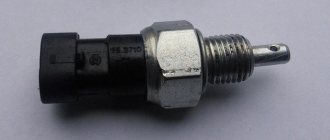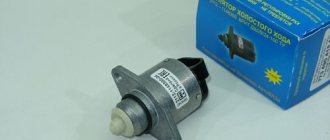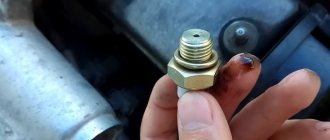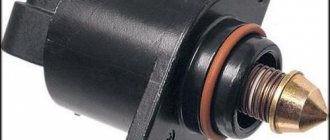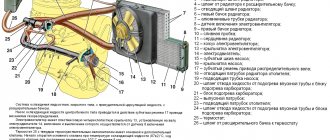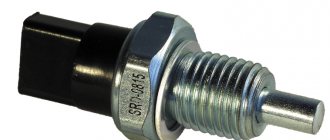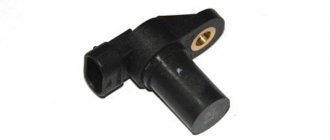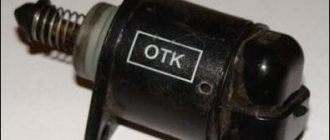Print this article Font size 16
The reverse sensor is designed to turn on white lights that signal you to start reversing. For some reason, many people think that this is a completely unnecessary device. Actually this is not true.
The sensor is responsible for turning on the light signal, thanks to which other road users can find out about your intentions and planned maneuvers. If it's dark outside, white lights will additionally signal to cars that you're on their way. This prevents many accidents and collisions.
But at some point the device may fail. Because of this, the risk of getting into an unpleasant traffic situation seriously increases. The only correct solution is to identify the problem and fix it.
DZH for the fourteenth
Location
First you need to understand where exactly the device is located.
You can go two ways:
- Fly under the bottom and look up at the suspension. The desired object on the VAZ 2114 is located on the gearbox. There are only two sensors - speed and reverse.
- If you don’t want to crawl under the car or can’t, try getting to the device through the engine compartment by opening the lid. Although the first option is objectively more convenient.
Device location
Video text
Replacing the reverse sensor. If the light does not come on when you turn on the reverse speed, then one of the reasons may be a malfunction of the reverse speed sensor, which is easy to change on your own. In this video I will show you how I changed the rear speed sensor on my car.
My videos are not instructions for repairing anything, I am simply sharing with you how I repair my car.
#replacing the rear speed sensor #VAZ 2114 #repairing a VAZ 2114 #do-it-yourself VAZ 2114 #reverse lights do not light #reverse lights do not light
The VAZ 2114 reverse sensor is a simple and at the same time necessary part that provides light signaling when the gearbox is switched to the reverse position.
The main tasks of the product: warning other traffic participants about an ongoing or planned maneuver. At night, when reversing, an additional useful function appears - illumination of a section of the road. The operating principle of the device is quite simple, and is based on the simple closure of contacts when the accelerator is switched to the rear position.
Functionality check
Before blaming the sensor for the malfunction of the reverse signals, make sure that the device has actually lost its functionality.
To do this, run the diagnostics:
- Turn the wheels to the left all the way and look at the sensor from the driver’s side - there is a protection on the side of the gearbox, and contacts inside it;
- Remove this protection and inspect the device. There are also two contacts going to the sensor;
- Close the contacts on the frog limit switches (this is the same reverse sensor) and start the engine, engaging reverse gear;
- If everything is fine, the wires and contacts are working properly, then the white headlights will turn on;
- If the headlights do not light, use a tester to check the voltage on the wire (orange) and ground;
- If there is voltage, check the light bulb board and the quality of the contacts.
Causes of the problem and solutions
There are several most common reasons why the DZH fails. But there are countermeasures that can return the sensor to operation.
| Causes of the problem | Actions |
| The contacts on the wiring have oxidized | They just need to be thoroughly cleaned and returned. In this case, the negative terminal of the battery must be disconnected |
| The sensor is loose | As the sensor is used, it may move out of its seat. Screw it in tighter |
| There is no contact with the wiring in the gearbox | Check the condition of contacts and wires. Clean or replace damaged parts |
| There is no contact between the plug and the fuse box | Also check the condition of the contacts, clean them, change the wiring |
| Fuse blown | Here the situation can only be corrected by replacing the fuse |
In some situations, the sensor is working properly, the contacts are intact and the wiring is undamaged. In this case, the light bulbs themselves burned out. They are easy enough to replace.
Diagnosis of problems
The reverse sensor on the VAZ 2114 may fail over time as a result of non-compliance with the operating rules of the vehicle. To diagnose its condition, perform the following actions:
- turn the wheels to the left;
- looking for contact protection;
- remove protection;
- consider the device itself and a pair of contacts going to it;
- perform a “frog” closure;
- engage gear (fourteenth).
If there are no problems with the wiring, contacts and light bulbs (the performance of all these elements is important), the white lights will light up. When there is no switching on, the tester measures the voltage of the red wiring and ground. If there is voltage, check the board. When there is no light, the contact of the sensor or safety valves has probably broken, it is necessary to test the entire unit. The DZH should be located and checked using appropriate equipment.
Repair methods
To repair the reverse signal, you can proceed in two ways. They differ in the way the sensor is accessed.
- Drive the car onto a lift or pit.
- Do the work by climbing under the car.
If you have already encountered a similar problem, then you will probably agree that replacing the DZH is best done using a pit or overpass. This makes access to the sensor as comfortable as possible, plus you minimize the risk of being splashed with oil from the gearbox.
Replacing the DZH is not the cleanest job
Of course, there is another cleanest way - sending the car to a car repair shop. But then you will have to pay not only for the sensor, but also for the services of the specialists. And this is another 2-3 times the cost of the sensor. The choice is yours anyway.
Self-replacement
It’s not difficult to get to and replace a failed DZH on your own. Follow the instructions, do not break the sequence of operations, and then the process will not take you much time and effort.
- Place the car on a pit or overpass. Be sure to apply the handbrake and place the transmission in first gear. This will help prevent your car from accidentally rolling away.
- Remove the protection from the contacts of your sensor, disconnect the contacts.
- Prepare a container into which the oil will be drained when unscrewing the DZH.
- When the container is ready, remove the sensor. In some cases, it may not be unscrewed by hand. In such a situation, use a 22 mm socket.
- Very rarely even the key cannot help, since the sensor becomes stuck to its location. Here you will have to arm yourself with a hammer and chisel and try to remove it as carefully as possible.
- Take out the failed device and insert a new one in its place.
- If oil gets on the gearbox housing, remove it with dry rags. There is no need for extra dirt. Plus, it can lead to a decrease in the efficiency of the device.
- Return all contacts to their places, put the protection back on.
- If a decent amount of lubricating fluid has spilled out of the box, be sure to top it up. Just use fresh ones. By the way, this is one of the reasons to completely change the oil in the gearbox if it has been there for more than the first season.
- The decision to change the oil will simplify the task when removing the sensor. If the liquid is drained in advance, it will not flow in different directions when the sensor is unscrewed. The work will be cleaner, plus you will kill two birds with one stone - replace the sensor and gearbox oil.
Removal and replacement
After completing the work, do not forget to check whether the reverse traffic warning system is now working.
For this:
- Turn the ignition key, but do not start the engine;
- Engage reverse gear on your gearbox;
- See if the white lights turn on. If yes, everything went great.
How much it costs?
Many VAZ 2114 owners are often interested in the cost of certain spare parts. In the case of DZH, a new device will cost you up to 300 rubles. You can find devices for 100 rubles.
The price depends on the manufacturer, quality level and pricing policy of the auto parts store where you decide to shop.
Additionally, it wouldn’t hurt to purchase WD40, which can be used to clean contacts. Plus, the wires may need to be replaced. We do not recommend doing this on your own if you do not have the relevant experience.
If the culprit for the problem with the rear lights is the light bulbs themselves, replacing them will cost a pittance. Today they cost up to 50 rubles.
Self-replacement
You can repair or replace the signal sensor yourself or at a service station. The second option is simple but expensive. Drivers independently perform VAZ maintenance on a pit or a lift; if they cannot be used, they climb under the car from below. You need to act carefully, as there is a risk of being splashed with oil from the gearbox.
- Place the car on an overpass, a hole, or climb under it from below.
- Engage the handbrake and put the gearbox in first gear - this will prevent the vehicle from accidentally rolling away.
- Remove the protection from the contacts and disconnect the contacts themselves.
- Place a container to drain the oil after unscrewing the reverse sensor.
- Remove the sensor - unscrew it manually or with a 22 mm diameter head.
- Remove the broken device and install a new, working one in its place. Another option is to diagnose the dismantled sensor, perform repair work and return it to its original place.
- Remove oil from the crankcase with a dry cloth, as drips reduce the efficiency of the unit.
- Return the previously removed contacts to their place.
- Wear protection.
If a lot of lubricant has leaked out of the gearbox, top it up. Be sure to use fresh oil, since used oil has a changed aroma, color, and incorrect characteristics. You can check the lubricant content in the system using a dipstick. When the volume is below the minimum level, urgent topping up is required.
After completing the service, check the system's functionality. To do this, turn the key in the ignition system, do not turn on the engine. Then put the car in reverse and see if the lights come on. If they burn, everything is fine.
About the reverse sensor VAZ 2114
Many years ago, drivers never dreamed that their vehicle would be illuminated when reversing. Today this is an ordinary, one might even say, mandatory function for any car. The white light in the headlights not only helps drivers when reversing in the dark, but also warns road users about such a maneuver during the day. Therefore, drivers should know what to do when the reversing lights of a VAZ 2114 do not light up. The reversing sensor, or DZH, as it is called in its abbreviated form, lights up the warning lights of the lights.
Reverse sensor for VAZ 2114
Price issue
If the price of a VAZ 2114 reverse sensor varies between 100-300 rubles, and you can install it yourself, then the problem in the wiring or with the headlight board will not be so easy for you.
Before purchasing wiring components, clean the contacts and spray with WD-40, this should help. Because the purchased wires also need to be installed wisely, and this is electronics - a delicate matter - available to craftsmen in the service for a good fee.
As for the headlight circuit board, this is also a controversial issue, requiring investment both in the part itself and in the work of a professional who will take care of it. Burnt out light bulbs in a headlight are the cheapest consumables; one light bulb costs 20-50 rubles.
Source
Where to find the reverse sensor for a VAZ 2114
It is not difficult to find the place where the reverse sensor is located. Two devices are installed at the checkpoint, one of them will be the DZH. It is installed at the bottom of the gearbox. This can be clearly seen in the figure below.
Location of the household farm
You can get good access to it when the machine is on an overpass, a lift or above an inspection hole.
The purpose of this device is that when reverse gear is engaged, it should light up a white light in the lamps. The lack of lighting does not mean that it is not working. There can be many reasons for this. For example, a light bulb or fuse has burned out, or a wire has come off.
What to do based on the cause of the breakdown
The procedure for restoring the VAZ 2114 reverse sensor will depend on the general picture of the malfunction:
- Oxidized wiring contacts must be thoroughly cleaned and then returned to their place. The negative terminal of the battery will need to be disconnected first.
- The loose sensor is screwed into place as tightly as possible.
- They test the wires, clean the problem parts or install new, serviceable elements instead of the problem ones - when there is no contact with the box.
- If there are problems connecting the plug to the block, check the contacts, clean them or change the wiring.
If a fuse blows, only replacing it will help.
Check the light bulbs themselves - they may be the reason for the lack of light if the wiring and contacts are intact. Faulty light bulbs are replaced.
Description of IAC
What is the IAC in the Four with an injector, what signs of malfunction are typical for it, where is the device located? You will find answers to these questions with photos and videos below; first, we recommend that you familiarize yourself with the basic information regarding this regulator.
Installation location and purpose
In VAZ 2114 and VAZ 2115 cars, the XX regulator is a device whose purpose is to stabilize the speed of the power unit at idle. The IAC is used to regulate the amount of air flow supplied to the fuel system when the throttle is closed. Accordingly, the engine speed is automatically adjusted. This regulator is located on the throttle body. The device is fixed in the seat using two bolts.
Operating principle
When you turn the key and turn on the ignition, the rod on the IAC extends to the end, as a result of which it rests against the calibration hole on the throttle line. After this, the regulator begins to count steps and returns the valve to its initial state. The position of the original valve directly depends on the firmware of the VAZ control unit. For example, in a car with a January 5.1 control unit on a fully warmed up engine, the number of steps is 120, and in a Bosch it is about 50.
When the power unit is warmed up, at the time of adjustment the IAC is located at around 30-50 steps. When the number of steps increases or decreases, the volume of air flow that passes through the technological opening changes regularly. When the rod extends, the number of revolutions increases, and when it retracts, it drops. The stroke of the rod is about 250 steps. A certain volume of air is supplied to the motor, which is needed for optimal functioning of the power unit.
The amount of supplied air is regulated by a flow meter - mass air flow sensor - in accordance with the volume, the control module supplies a certain amount of fuel to the engine through the injectors. This ensures an optimal ratio of air and fuel when forming a combustible mixture. If the engine is not warmed up, the control module increases the speed thanks to the IAC, which allows you to use the car for driving without warming up the internal combustion engine.
Which regulator is suitable for VAZ 2114 and 2115?
As for the most suitable regulator for the “Four” and “Fifteen”, judging by the reviews, the best option is the IAC Omega. The catalog number of these devices is 2112-114830. In addition, in practice, devices from the manufacturer KZTA have proven themselves well, number 2112-1148300-04. When purchasing, be sure to pay attention to the mark (in this case 04, but IACs with marks 01, 02, 03 are also produced) on the old and new regulator - they must match.
If the marks do not match, the regulator will not be able to work. You can use 01 instead of 03, and also 02 instead of 04 and vice versa. When buying a regulator, you need to measure the distance from the rod head to the flange - it should be no more than 2.3 cm . Find out how to distinguish a fake IAC from the original from the video published by the AutoLife channel.
Possible malfunctions and ways to eliminate them
What are the symptoms that indicate that the device has failed:
- the number of engine revolutions is not controlled - it can spontaneously increase and decrease;
- the power unit may randomly stall for no reason at idle;
- on a cold engine the driver cannot increase the speed;
- when additional equipment is turned on - optics, heater, wipers - the engine speed drops significantly, in particular, if the car is idling;
- The speed of the power unit may be increased, this is due to the development of the sensor cone.
If problems arise in the operation of the IAC device, the device must be cleaned or replaced.

